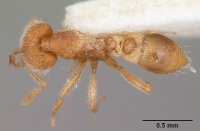Strumigenys habropilosa
| Strumigenys habropilosa | |
|---|---|

| |
| Scientific classification | |
| Kingdom: | Animalia |
| Phylum: | Arthropoda |
| Class: | Insecta |
| Order: | Hymenoptera |
| Family: | Formicidae |
| Subfamily: | Myrmicinae |
| Tribe: | Attini |
| Genus: | Strumigenys |
| Species: | S. habropilosa |
| Binomial name | |
| Strumigenys habropilosa Bolton, 2000 | |
Nothing is known about the biology of Strumigenys habropilosa.
Identification
Bolton (2000) - A member of the smythiesii complex in the Strumigenys godeffroyi-group. At first glance the two Indian species habropilosa and Strumigenys hypoturba form an unlikely pair as they have very different sculpture and ground-pilosity. However, both species have the following in common within the bounds of the species group and the smythiesii-complex: relatively short mandibles; a freely laterally projecting flagellate hair close to the occipital corner (posterior to the apicoscrobal hair); a row of long fine anteriorly-curved simple standing hairs along the occipital margin but no standing hairs anterior to this; numerous standing hairs on promesonotum. Separation of the two is simple, see key characters and details of descriptions.
Keys including this Species
Distribution
Distribution based on Regional Taxon Lists
Oriental Region: India (type locality).
Distribution based on AntMaps
Distribution based on AntWeb specimens
Check data from AntWeb
Countries Occupied
| Number of countries occupied by this species based on AntWiki Regional Taxon Lists. In general, fewer countries occupied indicates a narrower range, while more countries indicates a more widespread species. |

|
Estimated Abundance
| Relative abundance based on number of AntMaps records per species (this species within the purple bar). Fewer records (to the left) indicates a less abundant/encountered species while more records (to the right) indicates more abundant/encountered species. |

|
Biology
Castes
Nomenclature
The following information is derived from Barry Bolton's Online Catalogue of the Ants of the World.
- habropilosa. Strumigenys habropilosa Bolton, 2000: 807 (w.) INDIA.
Unless otherwise noted the text for the remainder of this section is reported from the publication that includes the original description.
Description
Worker
Holotype. TL 2.2, HL 0.62, HW 0.48, CI 77, ML 0.21, MI 34, SL 0.29, SI 60, PW 0.30, AL 0.62. Characters of smythiesii-complex. Apicoscrobal hair flagellate; dorsolateral margin of head with a second flagellate hair posterior to this, close to occipital corner; fringing pilosity of dorsolateral margin otherwise of very dense curved hairs throughout, these hairs are simple, long or very long, soft and fine. Cephalic dorsum shagreenate-rugulose, not evenly reticulate-punctate. In profile cephalic dorsum densely clothed with simple long soft fine ground-pilosity; occipital margin with a transverse row of 6-8 long fine simple standing hairs that are curved anteriorly, dorsum anterior to this with only ground-pilosity, without standing hairs. Pronotal humeral hair flagellate. Promesonotal dorsum reticulate-shagreenate. Pronotum and mesonotum each with 2-3 pairs of fine simple erect hairs, each also with shorter simple standing ground-pilosity. Middle and hind femora and tibiae each with 1-2 erect fine hairs on its dorsal (outer) surface. Waist segments and gaster with long fine standing hairs that are simple to subflagellate. Lateral spongiform lobe of petiole in profile subovate and high on side, located posteriorly on node, its anterior margin at about the midlength of the node. Dorsum of petiole node broader than long, disc of postpetiole smooth.
Type Material
Holotype worker, India: Madras, Nilgiri, 15 km. E Coonoor, 900 m., 19.xi.1972, no. 37 (Besuchet, Lobl & Mussard) (Musee d'Histoire Naturelle Genève).
References
- Bharti, H. & Akbar, S.A. 2013. Taxonomic studies on the ant genus Strumigenys Smith, 1860 (Hymenoptera, Formicidae) with report of two new species and five new records including a tramp species from India. Sociobiology 60, 387-396 (doi:10.13102/sociobiology.v60i4.387-396).
- Bolton, B. 2000. The ant tribe Dacetini. Memoirs of the American Entomological Institute. 65:1-1028. (page 807, worker described)
- Tang, K. L., Guénard, B. 2023. Further additions to the knowledge of Strumigenys (Formicidae: Myrmicinae) within South East Asia, with the descriptions of 20 new species. European Journal of Taxonomy 907, 1–144 (doi:10.5852/ejt.2023.907.2327).
References based on Global Ant Biodiversity Informatics
- Dad J. M., S. A. Akbar, H. Bharti, and A. A. Wachkoo. 2019. Community structure and ant species diversity across select sites ofWestern Ghats, India. Acta Ecologica Sinica 39: 219–228.

